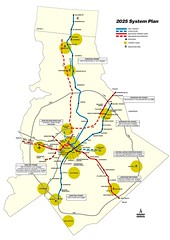Charlotte Light Rail and Transit
Is about to open in November, but is under threat. I think I blogged about this a few months ago, about an initiative on the ballot that would repeal a 1/2 cent sales tax dedicated to public transit (specifically not roads) levied in Charlotte-Mecklenberg County, North Carolina.
The Charlotte Observer has a piece "If transit tax is repealed, what's next?," subtitled "Some say put levy back on ballot; others want to use it to build roads," about two of the differing anti-tax groups, and a discussion of the impact on property taxes from the City of Charlotte. The piece has links to the two anti-tax groups, one group sees the possibility of expanding transit in the future if the light rail is successful, the other is pro-road.
Also see these articles from the Charlotte Observer, "Black community split on transit tax" and "Residents focus of pro-transit campaign."
The incumbent Republican mayor warded off a challenge from an anti-transit tax opponent in the primary this month, so maybe this is a positive sign in terms of what will happen in November. See "Transit tax camps spin vote results."
I find this interesting not just because of my interest in transit, but because the pro-sprawl/pro-road argument is similar to the pro-property rights anti-historic preservation arguments that I deal with in historic preservation.
For the most part, pro-road types vehemently argue against transit and their arguments are fueled by the anti-government groups such as the Reason Foundation, Cato Institute, and others.
In some respects you can understand their arguments. You can't put the genie back in the bottle in terms of development/the sprawl paradigm, because you can't tear down subdivisions and build over.
In places with a strong compact development framework, transit can work exceedingly well. Now the federal government won't pay for tunneling, so inserting transit above ground becomes the standard, and almost by definition it is pretty costly too, because of the land acquisition costs. Land costs and "congestion" justify tunneling in areas of great density, such as a downtown central business district.
So of the "next generation" transit systems from the 1960s and 1970s, there is no question that DC's system is the most successful. And pre-existing systems in Chicago, Toronto, New York City, and San Francisco demonstrate similar success in North America.
I can't explain why Philadelphia isn't a strong real estate market even though it has a pretty good transit system, with subway and streetcar service. However, the place with the best transit, downtown (or "Center City") has experienced a great deal of growth and in-migration even though the entire city has not. This is likely for the same reason that the core of DC (the 15 square mile core from Van Ness and Brookland on the north, from GWU on the west and the Stadium-Armory Station on the east), with 29 subway stations is experiencing the most improvement (in-migration, new construction, investment in commercial districts).
It's all about density of transit service and frequency and reliability (although that has been an issue in DC as of late).
Labels: civic engagement, transit, transportation planning




0 Comments:
Post a Comment
<< Home